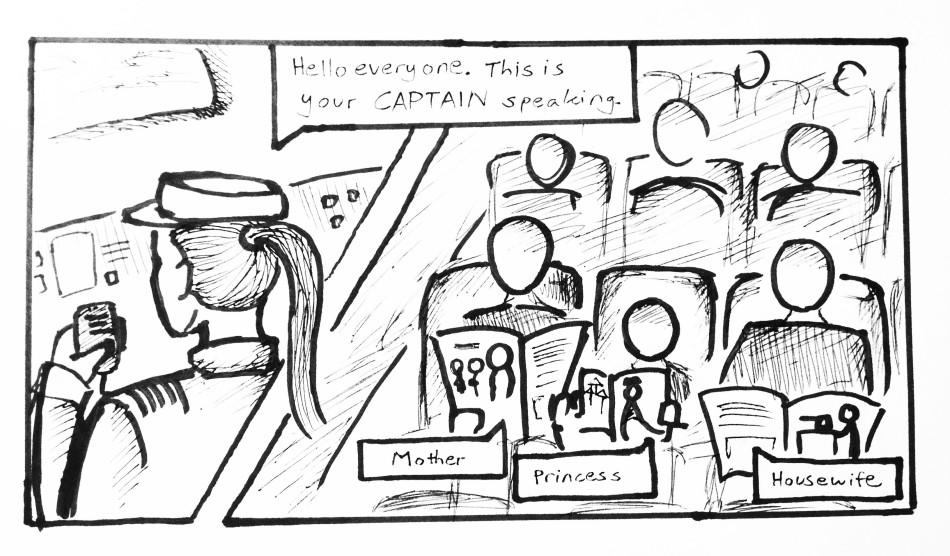Editorial: Shifting the scale towards gender balance
Feminism may seem like a fight of the past, but in reality, it can’t be cast aside or taken for granted.
Just last week, a female WestJet pilot received a note on her seat from a male passenger that read “the cockpit of an airliner is no place for a woman. A woman being a mother is the most honor, not as captain.”
Last month, a Duke freshman stood up for herself after being cast in a negative light by the campus newspaper for resorting to pornography as a means to pay for her college education.
These are only two of many feminist issues that have made headlines recently. Society has created an image of women influenced by gender categorization and a formerly male-dominated culture. In several media and film outlets, women are stereotypically portrayed as shopaholics and housewives.
Gender disparity is often most noticeable, and most heavily criticized, in professional spheres, especially those in the sciences. According to The New York Times, only one-fifth of the physics Ph.D.’s in the world are awarded to women. Additionally, women still earn between 4.8 and 7.1 percent less than men for the same jobs, according to a 2009 analysis by the United States Department of Labor.
Despite the monumental strides towards occupational equality that have been made in the last decades, the gender inequality still exists. American culture still regards certain professions, such as librarians and nurses, as “reserved for females.”
This discrepancy is also evident in Harker classrooms. Although we’re closer to gender-balanced classrooms than many other schools in our area, we still perpetuate the “girl sciences” versus “boy sciences” stereotype, even if unintentionally. Discussions among students during course selection reveals assumptions that girls are more likely to take advanced classes in subjects like chemistry and biology, whereas boys often take physics or computer science. With only one female enrolled in an 11-person Engineering class, the gender imbalance is worth noting.
Establishing gender balance in classrooms containing the students who will become the future of the workplace is one step closer towards diminishing occupational inequality.
Gender stereotypes aren’t just workplace concerns. In a truly equal society, it would be just as normal for a girl to ask a boy to a dance as it is for a boy to ask a girl. Although that’s not yet the case, events like Sadies promote independence and gender equity and encourage young women to transcend the generally accepted norm.
In 1972, the senate passed Title IX, an Education Amendment that prohibited gender discrimination in school programs and activities. That law is the reason that we have a girls’ soccer team and a boys’ basketball team that made school history this year.
Being a feminist is no longer about protests or propaganda. It’s about taking advantage of the equal opportunities we do have, it’s about supporting our girl sports just as much as our boy sports, and it’s about taking the classes that we want to take, regardless of stereotypes.
This piece was originally published in the pages of the Winged Post on March 12, 2014.

Kacey Fang (12) is the Managing Editor for The Winged Post. She has been part of the journalism program since freshman year and served as Features Editor...


















![“[Building nerf blasters] became this outlet of creativity for me that hasn't been matched by anything else. The process [of] making a build complete to your desire is such a painstakingly difficult process, but I've had to learn from [the skills needed from] soldering to proper painting. There's so many different options for everything, if you think about it, it exists. The best part is [that] if it doesn't exist, you can build it yourself," Ishaan Parate said.](https://harkeraquila.com/wp-content/uploads/2022/08/DSC_8149-900x604.jpg)




![“When I came into high school, I was ready to be a follower. But DECA was a game changer for me. It helped me overcome my fear of public speaking, and it's played such a major role in who I've become today. To be able to successfully lead a chapter of 150 students, an officer team and be one of the upperclassmen I once really admired is something I'm [really] proud of,” Anvitha Tummala ('21) said.](https://harkeraquila.com/wp-content/uploads/2021/07/Screen-Shot-2021-07-25-at-9.50.05-AM-900x594.png)







![“I think getting up in the morning and having a sense of purpose [is exciting]. I think without a certain amount of drive, life is kind of obsolete and mundane, and I think having that every single day is what makes each day unique and kind of makes life exciting,” Neymika Jain (12) said.](https://harkeraquila.com/wp-content/uploads/2017/06/Screen-Shot-2017-06-03-at-4.54.16-PM.png)








![“My slogan is ‘slow feet, don’t eat, and I’m hungry.’ You need to run fast to get where you are–you aren't going to get those championships if you aren't fast,” Angel Cervantes (12) said. “I want to do well in school on my tests and in track and win championships for my team. I live by that, [and] I can do that anywhere: in the classroom or on the field.”](https://harkeraquila.com/wp-content/uploads/2018/06/DSC5146-900x601.jpg)
![“[Volleyball has] taught me how to fall correctly, and another thing it taught is that you don’t have to be the best at something to be good at it. If you just hit the ball in a smart way, then it still scores points and you’re good at it. You could be a background player and still make a much bigger impact on the team than you would think,” Anya Gert (’20) said.](https://harkeraquila.com/wp-content/uploads/2020/06/AnnaGert_JinTuan_HoHPhotoEdited-600x900.jpeg)

![“I'm not nearly there yet, but [my confidence has] definitely been getting better since I was pretty shy and timid coming into Harker my freshman year. I know that there's a lot of people that are really confident in what they do, and I really admire them. Everyone's so driven and that has really pushed me to kind of try to find my own place in high school and be more confident,” Alyssa Huang (’20) said.](https://harkeraquila.com/wp-content/uploads/2020/06/AlyssaHuang_EmilyChen_HoHPhoto-900x749.jpeg)



